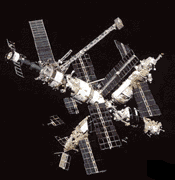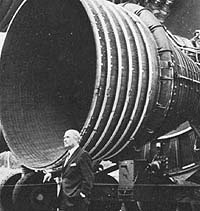Manned Space FlightSince the days of Sputnik and Explorer 1, thousands of spacecraft have gone into space, some of them carrying human passengers. The first person to orbit the Earth was the Russian Yuri Gagarin, on April 12, 1961. The first American to do so was John Glenn, who completed three orbits on February 20, 1962; more than 26 years later, at age 77, Glenn returned to space aboard the space shuttle.
Glenn's flight was the first in "Project Mercury" which adapted the Atlas missile. It was followed (in the US) by "Gemini" whose two-man capsules were orbited by the more powerful Titan rocket. Then came the three-man "Apollo" missions, first flying around the Moon and then landing on its surface, on July 20, 1969. Altogether 6 successful landings on the moon were achieved, all using the giant (2700 ton) Saturn V rocket, powered by five huge F-1 rocket engines (and one more on the second stage). One such engine is displayed in the National Air and Space Museum (NASM) of the Smithsonian Institution in Washington, as is John Glenn's capsule, a Moon lander and many other mementos from the early days of spaceflight.
The story of manned spaceflight is fascinating and long, and it still continues to unfold. This short account cannot possibly do it justice, and those who wish to know more are directed to other resources available. Today manned spaceflight is based on the space shuttle, a reusable rocket vehicle with short wings, which allow it to land on a runway like an airplane. The shuttle's rockets use about 700 tons of liquid hydrogen and oxygen, a most effective fuel; in addition it carries two strap-on solid fuel rockets, each weighing about 600 tons. Manned satellites include various "space stations" intended for long-term residence. In the past, the US flew "Skylab," launched in 1973 and burned up in its atmospheric re-entry in 1980, long after its last occupants had left; a backup Skylab module is open to visitors at the NASM. 
The USSR launched space-stations of gradually increasing size, the Soyuz, Salyut and (in 1986) the Mir space station (on right). Over the years Mir was extended by additional modules (one of which was damaged by an accidental collision in 1997) and was still operating in 2000. It finally re-entered the atmosphere on 23 March 2001, near the Fiji islands in the Pacific Ocean. Its re-entry was observed from the ground and fragments which did not burn up splashed harmlessly into the ocean. Construction of the International Space Station began in November 1998 with the placing in orbit of the Russian module "Zarya", followed in December by NASA's "Unity." As of the end of 2000, a US-Russian crew is stationed aboard it. ReentryAny manned mission faces the problem of safe return to Earth, which requires getting rid of the huge amount of energy associated with orbital motion. A spacecraft in low Earth orbit moves at about 24 times the velocity of sound. Since the energy of motion ("kinetic energy") is proportional to the square of the velocity v, gram for gram (or ounce for ounce) such a spacecraft carries 242 = 576 times more energy than an object moving at the velocity of sound (in air), e.g. a typical pistol bullet. Atmospheric friction converts this energy into heat, enough heat than to melt or even evaporate the re-entering material, even if it is a tough metal. To get rid of this heat, the vehicle re-enters the atmosphere at a shallow angle, stretching out the time spent in the more rarefied upper layers. It is also useful to present a blunt obstacle to the air, creating a strong shock front well ahead of the reentry vehicle, which dissipates much of the heat. For this reason the space shuttle starts re-entering the atmosphere bottom-first, and only after almost all its velocity is lost does it turn around to the nose-first attitude of an airplane. 
Still, a great amount of heat reaches the spacecraft, requiring its forward-facing part to be lined with heat-resistant material. Mercury, Gemini and Apollo used shields which gradually wore down (ablated), sparing the spacecraft which then landed by parachute. The shuttle's bottom is lined with lightweight heat-resistant tiles of a special material. The Soviet Union built and in 1988 flew its own space shuttle, the Buran, but though its tests were successful, it was not used afterwards.
Unmanned SpacecraftSo great is the variety of unmanned spacecraft that (as with manned spaceflight) it is impossible to cover all of it here. They can be divided into five groups, described separately in files linked to the list below:
Exploring Further:A book on Yuri Gagarin: "Starman: The Truth Behind the Legend of Yuri Gagarin" by Jean Doran and Piers Bizony, Bloomsbury (Great Britain) 1998. Questions from Users: Is a heat shield needed while going up? Also: *** Why is the path of reentry from space so critical?. *** Spacecraft Attitude *** Re-entry from orbit *** Sticking a hand out of a window... *** Shuttle re-entry from space |
Next Stop after the ones cited above: #30 Far-out Pathways to Space: Great Guns?
Timeline Glossary Back to the Master List
Author and Curator: Dr. David P. Stern
Mail to Dr.Stern: stargaze("at" symbol)phy6.org .
Last updated: 9-24-2004